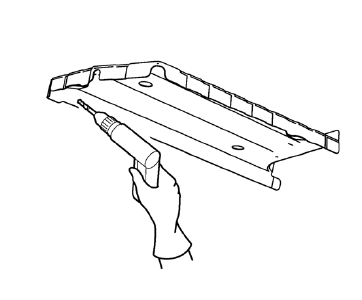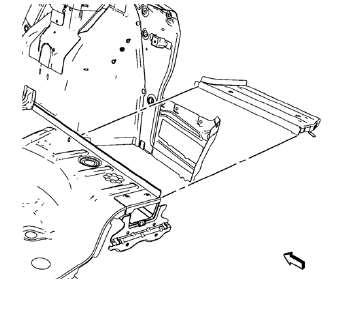Chevrolet Cruze Repair Manual: Installation Procedure

Note: If the location of the original plug weld holes can not be determined, space the plug weld holes every 40 mm (1½ in).
- Drill 8 mm (5/16 in) for plug welding along the edges of the rear floor panel filler as noted from the original panel.
- Clean and prepare the attaching surfaces for welding.

- Position the rear floor panel filler on the vehicle.
- Verify the fit of the rear floor panel filler.
- Clamp the rear floor panel filler into position.

- Plug weld accordingly.
- Apply the sealers and anti-corrosion materials to the repair area, as necessary. Refer to Anti-Corrosion Treatment and Repair.
- Paint the repaired area. Refer to Basecoat/Clearcoat Paint Systems.
- Install all related panels and components.
- Connect the negative battery cable. Refer to Battery Negative Cable Disconnection and Connection.
- Enable the SIR system. Refer to SIR Disabling and Enabling.
 Removal Procedure
Removal Procedure
Warning: Refer to Approved Equipment for Collision Repair Warning in the
Preface section.
Warning: Refer to Glass and Sheet Metal Handling Warning in the Preface section.
Disable the SIR Syst ...
 Rear Floor Panel Filler Replacement (MIG-Brazing)
Rear Floor Panel Filler Replacement (MIG-Brazing)
Note: According to different corrosion warranties, only the
regional mandatory joining methods are allowed. ...
Other materials:
Front Seat Track Synchronization
The fore/aft manual adjuster is composed of an inboard track assembly (5),
and outboard track (4) assembly, and an adjuster handle (1).
Each track assembly is made of an upper track (2) and a lower track (3). Both
tracks need to be aligned prior to installing in the vehicle.
To align t ...
Front Wheel Drive Shaft Replacement - Left Side
Special Tools
CH-313 Slide Hammer
CH-6003 Axle Shaft Remover
CH-46376 Holding Wrench
CH-49400 Hub Spindle Remover
DT-6332 Seal Protector
EN-956-1 Extension
For equivalent regional tools, refer to Special Tools.
Removal Procedure
Warning: To prevent personal injury and/or component ...
Radio(s)
: Press to turn the system on and
off. Turn to increase or decrease the volume.
BAND: Press to choose between FM, AM, or SiriusXM®, if equipped.
MENU/SEL: Turn to select radio stations. Press to select a menu.
: Press to seek the previous station
or track.
: Press to seek the next station
...
